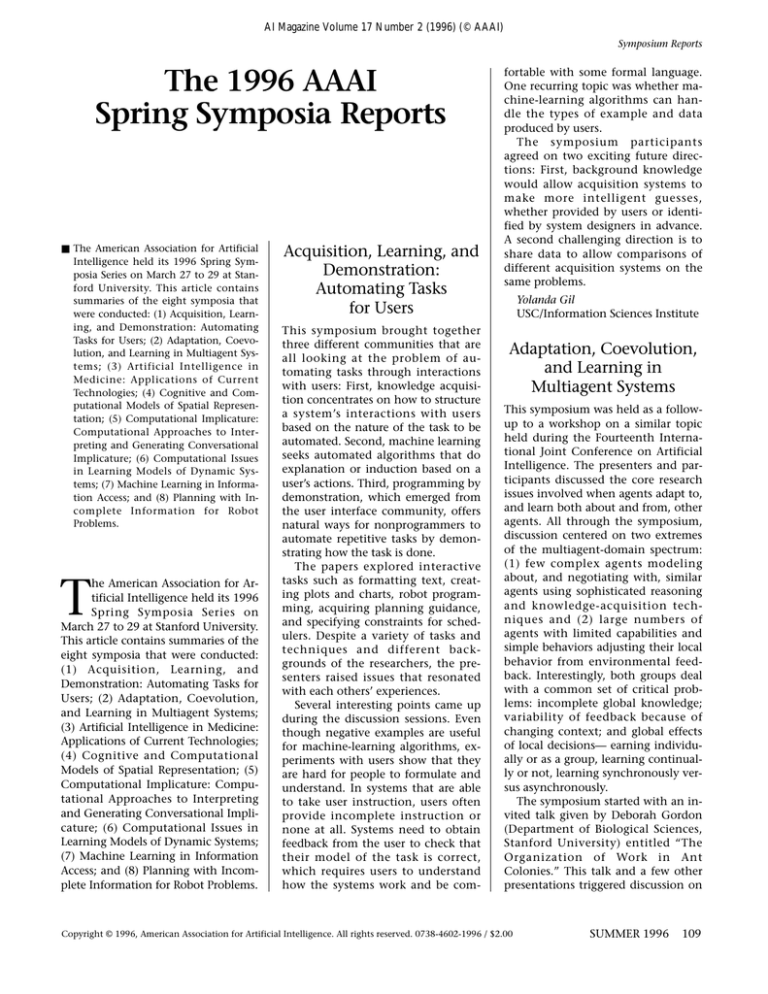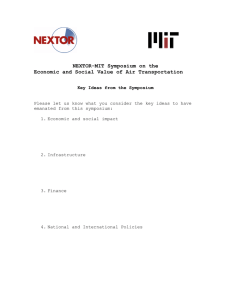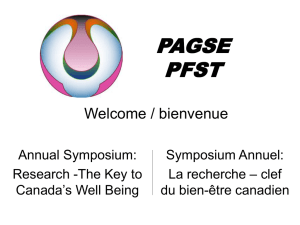
AI Magazine Volume 17 Number 2 (1996) (© AAAI)
Symposium Reports
The 1996 AAAI
Spring Symposia Reports
■ The American Association for Artificial
Intelligence held its 1996 Spring Symposia Series on March 27 to 29 at Stanford University. This article contains
summaries of the eight symposia that
were conducted: (1) Acquisition, Learning, and Demonstration: Automating
Tasks for Users; (2) Adaptation, Coevolution, and Learning in Multiagent Systems; (3) Artificial Intelligence in
Medicine: Applications of Current
Technologies; (4) Cognitive and Computational Models of Spatial Representation; (5) Computational Implicature:
Computational Approaches to Interpreting and Generating Conversational
Implicature; (6) Computational Issues
in Learning Models of Dynamic Systems; (7) Machine Learning in Information Access; and (8) Planning with Incomplete Information for Robot
Problems.
T
he American Association for Artificial Intelligence held its 1996
Spring Symposia Series on
March 27 to 29 at Stanford University.
This article contains summaries of the
eight symposia that were conducted:
(1) Acquisition, Learning, and
Demonstration: Automating Tasks for
Users; (2) Adaptation, Coevolution,
and Learning in Multiagent Systems;
(3) Artificial Intelligence in Medicine:
Applications of Current Technologies;
(4) Cognitive and Computational
Models of Spatial Representation; (5)
Computational Implicature: Computational Approaches to Interpreting
and Generating Conversational Implicature; (6) Computational Issues in
Learning Models of Dynamic Systems;
(7) Machine Learning in Information
Access; and (8) Planning with Incomplete Information for Robot Problems.
Acquisition, Learning, and
Demonstration:
Automating Tasks
for Users
This symposium brought together
three different communities that are
all looking at the problem of automating tasks through interactions
with users: First, knowledge acquisition concentrates on how to structure
a system’s interactions with users
based on the nature of the task to be
automated. Second, machine learning
seeks automated algorithms that do
explanation or induction based on a
user’s actions. Third, programming by
demonstration, which emerged from
the user interface community, offers
natural ways for nonprogrammers to
automate repetitive tasks by demonstrating how the task is done.
The papers explored interactive
tasks such as formatting text, creating plots and charts, robot programming, acquiring planning guidance,
and specifying constraints for schedulers. Despite a variety of tasks and
techniques and different backgrounds of the researchers, the presenters raised issues that resonated
with each others’ experiences.
Several interesting points came up
during the discussion sessions. Even
though negative examples are useful
for machine-learning algorithms, experiments with users show that they
are hard for people to formulate and
understand. In systems that are able
to take user instruction, users often
provide incomplete instruction or
none at all. Systems need to obtain
feedback from the user to check that
their model of the task is correct,
which requires users to understand
how the systems work and be com-
fortable with some formal language.
One recurring topic was whether machine-learning algorithms can handle the types of example and data
produced by users.
The symposium participants
agreed on two exciting future directions: First, background knowledge
would allow acquisition systems to
make more intelligent guesses,
whether provided by users or identified by system designers in advance.
A second challenging direction is to
share data to allow comparisons of
different acquisition systems on the
same problems.
Yolanda Gil
USC/Information Sciences Institute
Adaptation, Coevolution,
and Learning in
Multiagent Systems
This symposium was held as a followup to a workshop on a similar topic
held during the Fourteenth International Joint Conference on Artificial
Intelligence. The presenters and participants discussed the core research
issues involved when agents adapt to,
and learn both about and from, other
agents. All through the symposium,
discussion centered on two extremes
of the multiagent-domain spectrum:
(1) few complex agents modeling
about, and negotiating with, similar
agents using sophisticated reasoning
and knowledge-acquisition techniques and (2) large numbers of
agents with limited capabilities and
simple behaviors adjusting their local
behavior from environmental feedback. Interestingly, both groups deal
with a common set of critical problems: incomplete global knowledge;
variability of feedback because of
changing context; and global effects
of local decisions— earning individually or as a group, learning continually or not, learning synchronously versus asynchronously.
The symposium started with an invited talk given by Deborah Gordon
(Department of Biological Sciences,
Stanford University) entitled “The
Organization of Work in Ant
Colonies.” This talk and a few other
presentations triggered discussion on
Copyright © 1996, American Association for Artificial Intelligence. All rights reserved. 0738-4602-1996 / $2.00
SUMMER 1996
109
Symposium Reports
whether the assumption that more
global knowledge is better is really essential for achieving coordination in
all multiagent systems. A related issue
on which the participants reached
consensus was that for agent groups
to be stable, some asymmetry or diversity (in knowledge, capability, decision times, and so on) of behavior
seems to be essential. Other prominent issues that were discussed included application of multiagent
learning systems (design, information
gathering), cooperative versus competitive learning and evolution, and
test beds (robotic soccer). More details can be found at http://
euler.mcs.utulsa.edu/~sandip/ss.html.
Sandip Sen
University of Tulsa
Artificial Intelligence in
Medicine: Applications of
Current Technologies
Bruce Buchanan set the tone for the
Artificial Intelligence in Medicine
(AIM) symposium with his keynote address describing the dramatic changes
in health-care delivery. He noted that
these changes presented several opportunities for the AIM community to affect clinical care in the direct care of
patients as well as at the administrative level. The symposium itself
demonstrated a transition from past
years from tool development to working prototypes and clinical deployment. Machine-learning techniques,
expert systems, and classification algorithms were embedded in user interfaces so that they appear almost invisible to the clinician user. Furthermore,
there was much greater use of existing
clinical databases and less reliance on
manual data entry than in years past.
The AIM community is clearly not immune to the larger trends in the computing community because many applications were built around new
information-presentation and information-delivery technologies such as
the World Wide Web and voice and
handwriting recognition.
Isaac Kohane
Children’s Hospital and
Harvard Medical School
110
AI MAGAZINE
Cognitive and
Computational Models of
Spatial Representation
One result of recent IJCAI and AAAI
workshops on spatial language and
the 1995 Fall Symposium on Computational Models for Integrating Language and Vision was the recognition
of the rift that exists between cognitive and computational accounts of
spatial representation. The principal
aim of this symposium was to initiate
an interdisciplinary dialogue to facilitate exchange of ideas and cross-fertilization among researchers into spatial representation, reasoning, and
cognition.
As was planned, the event attracted
interest from a wide range of disciplines, not only computer science
and cognitive psychology but also geography, neurology, and philosophy.
Over 80 papers and statements of interest were submitted, and the symposium was one of the largest in this
symposium series with nearly 70 attendees.
Rather than being skeptical and absolutely critical of different views and
approaches, which often results in accusations about the naiveté and ignorance of other disciplines, participants were actively supportive and
constructive; the symposium atmosphere was positive and friendly. Topics presented spanned cognitive and
computational accounts of spatial
language, diagrammatic reasoning,
spatial cognition, and cognitive
maps.
To focus understanding on particular problem areas, three overview
talks were delivered: (1) Barbara Tversky on cognitive aspects of linguistic
accounts of spatial descriptions, (2)
Janice Glasgow on computational imagery and its impact on diagrammatic reasoning, and (3) Tony Cohn on
qualitative spatial reasoning based on
spatial logic. Along with these general issues in each discipline, the symposium discussed 13 paper presentations over the 2-1/2 days. Two
commentators from varying backgrounds were assigned to each paper
and presented their concerns and
comments, which served as pretexts
to the discussion. Often, the com-
mentaries were as captivating and
stimulating as the paper presentation
itself and posed well–thought-out
questions that brought the ensuing
discussion to a well-informed debate.
Patrick Olivier and Keiichi Nakata
University of Wales at Aberystwyth
Computational
Implicature:
Computational
Approaches to Interpreting
and Generating
Conversational
Implicature
A conversational implicature (CI) is a
type of discourse inference (Grice, H.
P. 1975. Logic and Conversation. In
Syntax and Semantics III: Speech Acts,
eds. P. Cole and J. L. Morgan. San
Diego, Calif.: Academic). For example, B’s response below licenses the
CI that B has no more than two children.
A: Do you have any children?
B: I have 2 children.
Since the 1980s, various approaches
have been developed for interpreting
and generating classes of CIs and for
generating discourse that avoids unintended CIs. The symposium
brought together an international
group of researchers from computational linguistics, linguistics, philosophy, and cognitive science. The purpose was to compare computational
solutions, discuss how these solutions
might be integrated, and stimulate
future directions for research.
The first half of the symposium
gave attendees an overview of current
research. The second half included
two panels: (1) one comparing different computational approaches and
(2) the other on the proper role of
Grice’s theory. Finally, attendees participated in smaller working groups
to devise a comprehensive generation
and interpretation model and address
future methodological and theoretical issues.
Themes that arose from the symposium’s lively discussions include a
closer examination of naturally oc-
Symposium Reports
curring examples in context; the role
that plans and goals play in computational models of CI, especially in a
generator’s decision to employ cancellation or reinforcement of potential CIs; and the need to address dynamic aspects of modeling CI.
Further details can be found at
http://www.isp.pitt.edu/implicature/.
Barbara Di Eugenio and Nancy Green
Carnegie Mellon University
Computational Issues in
Learning Models of
Dynamic Systems
Dynamic systems are mathematical
objects used to represent the behavior of physical phenomena evolving
over time. This symposium brought
together physicists, computer scientists, and applied statisticians in an
attempt to better understand the
models, statistical techniques, and algorithms for inferring dynamic systems from data.
Traditionally, physicists are concerned with the basic phenomena
and are interested in providing explanatory theories. Physicists conceptualize dynamic systems in terms of
attractor-basin portraits, models that
are used frequently in model-based
learning in AI and qualitative reasoning in particular. The physicists also
addressed the issue of measurement,
which is often neglected in more abstract discussions of dynamic systems.
Applied statisticians working in the
area of time-series analysis and hidden Markov models are interested in
the relation between data and models
that attempt to summarize the data
succinctly and generalize to account
for unobserved features. There was
much consciousness raising in terms
of issues of bias; the role of the socalled no-free-lunch theorems; and
the use of mixture models, that is, instead of choosing a single model,
Bayesians prefer using a probabilityweighted combination of models.
The computer scientists included
computational learning theorists and
problem-driven but theoretically
well-informed AI researchers interest-
ed in learning dynamic systems for
applications in robotics; economic
forecasting; and the control of complex devices, including spacecraft and
maglev trains. Both physicists and
computer scientists drew on linkages
to formal language models and automata theory as one method of accounting for computational issues.
The computer scientists were concerned with building algorithms that
scale well (in terms of time and
space) with problem size and identifying and exploiting structural properties that help to reduce computational overhead. Particular methods
involving decomposition and aggregation were discussed in regard to the
latter. There are plans for follow-on
workshops.
Thomas Dean
Brown University
Machine Learning in
Information Access
This symposium was the first professional gathering devoted to the use of
machine-learning techniques to enable and improve information-access
(that is, information-retrieval) tasks.
Presentations described applications
on a range of tasks, such as finding
interesting pages on the World Wide
Web, identifying text topics, and email filtering.
One central theme of the symposium—labeled by Bill Cooper in his
lead-off invited talk as the rubber ceiling effect—was that sophisticated
methods rarely generate results that
are substantially better than those of
more straightforward approaches.
One question this raised was whether
sophisticated methods would find
success on niche problems, such as
constrained classes of information
sources or information-access tasks.
Discussions also addressed a number
of more technical questions, such as
how to evaluate work in the context
of real users and how to select good
features for learning from text.
More generally, though, many attendees emphasized the need to
“break out of the box” in terms of the
problems, methods, and evaluation
criteria studied by researchers in this
One central
theme of the
symposium—
labeled by
Bill Cooper
in his
lead-off
invited talk
as the
rubber ceiling
effect—was
that
sophisticated
methods
rarely
generate
results that are
substantially
better than
those of
more
straightforward
approaches.
area. For example, as pointed out by
Rich Sutton in his invited talk, information access is often an iterative
process of formulating a query or information request, then refining it
based on the retrieved information in
contrast to the one-shot model of information access that is common in
much of the work in this area. For
further information, the symposium’s
web page can be found at
http://www.parc.xerox.com/mlia.
Marti Hearst
Xerox PARC
SUMMER 1996
111
Symposium Reports
Planning with
Incomplete Information
for Robot Problems
This symposium brought together
the planning and robotics communities to address the common problem
of planning and acting robustly in
spite of incomplete information (actions backfire, camera lenses crack,
graduate students block the robot’s
path, and so on). Stan Rosenschein
(Teleos Research and Stanford University) set the tone with a keynote address on the automatic design of control systems that track the world and
achieve their goals. Subsequent presentations described planning systems capable of constructing solutions despite incomplete information
as well as control systems that allow
multiple episodes of planning and execution, gaining perceptual information at execution time to simplify
subsequent planning episodes.
112
AI MAGAZINE
The planning and robotics communities have converged on perhaps
the biggest lesson of incomplete information: Planning and execution
must be interleaved if an agent is to
function in the uncertain real world.
The point was made dramatically in
a presentation by Anthony Stentz
(Carnegie Mellon University). He
demonstrated an extremely effective
navigation strategy for a robot in an
unknown environment. The surprise
was that his robot replans globally
each time it encounters an unexpected obstacle, successfully interleaving
planning and execution to an extreme degree.
A final ingredient of the symposium was a one-session robot laboratory using four actual robots in a
large maze world. Low-level motion
code was supplied before the symposium and attendees were asked to
provide planning- and executioncontrol systems that would allow the
robot to gather gold balloons at specified positions in the maze despite
complete initial uncertainty about its
starting position.
Several participants designed successful control systems, demonstrating perhaps for the first time that an
individual can write high-level control code for a real-world robot several thousand miles removed from the
robot, and it can work on the actual
robot on the first try.
Illah R. Nourbakhsh
Stanford University



